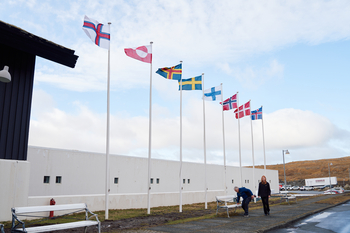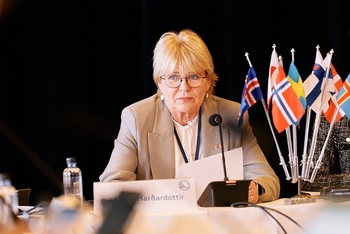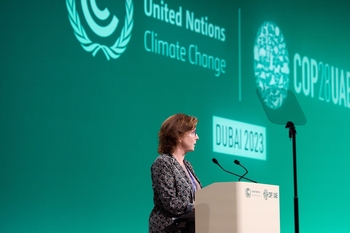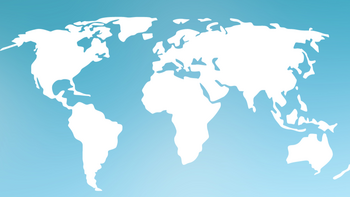Future of the Nordic model in focus at high-level event in Washington D.C.
Under the heading “The Nordic model under pressure – will it survive?” Secretary General of the Nordic Council of Ministers, Mr. Dagfinn Høybråten, on February 18 delivered a comprehensive analysis of the state of affairs in the Nordic region in a speech at the Centre for Transatlantic Relations, Johns Hopkins University in Washington D.C.
Outlining both the values underlying Nordic cooperation as well as the hard facts showing the relative success of the Nordic countries in socio-economic terms, Mr. Høybråten made a strong case for the future survival of the Nordic model, despite the foreboding title of his talk.
Distinctive but not unique
What characterizes “The Nordic model” is a strong welfare society combining market mechanisms with a high level of taxation and a public efficient regulation in a wide array of sectors. The Nordic countries are among the most equal in the world both in terms of economic parameters and gender equality.
- Overall the situation in the Nordic countries can be described as a social contract whereby citizens accept high levels of taxes because they get something in return in terms of free health care, free education, well developed infrastructure, high unemployment benefits and so on, said Mr. Høybråten.
This model is distinctive, but not unique, he pointed out, underlining one central feature that does stand out, however, namely the high level of trust between citizens and government as well as between people in general.
Socialism or simply pragmatism?
Since the Economist heralded the Nordics as the new super models a few years back much international attention has been given to whether the Nordic model is viable and whether it should indeed be inspiration for others.
In the on-going primaries in the run up to the US presidential election next fall the Nordic countries have even been heralded as a role model also for the USA by some candidates.
The audience at Johns Hopkins questioned this and even wondered about the very nature of the Nordic model.
- The interest in the Nordic countries at the moment is very big, which is positive, despite some misunderstandings. It is important to understand that the Nordics are not tightly regulated socialist states without room for individual enterprise. On the contrary, innovation is a paramount feature and the Nordic countries are liberal economies with a corporate taxation that is in many cases lower than in the US, Dagfinn Høybråten underlined.
When asked about his message for the future US President, he added:
- Look at the Nordics as a region that punches above its weight. The Nordic countries are leading within the area of green solutions and sustainable development and have the potential to be a crucial player and a key partner also for the United States.
Look at the Nordics as a region that punches above its weight. The Nordic countries are leading within the area of green solutions and sustainable development and have the potential to be a crucial player and a key partner also for the United States.Immigrants and refugees knock at the door
As is the case in the rest of Europe, the refugee crisis has set the agenda over the last months.
The situation has temporarily influenced corner stones in the Nordic cooperation such as the free mobility over borders. Much focus has also been on some of the measures taken in response and it has also led to a discussion of whether the Nordics have lived up the high standards they themselves have set in terms of human rights.
- Four Nordic countries, Sweden, Norway, Finland and Denmark are in the top-10 of the OECD countries receiving most refugees when looking at asylum applicants per million inhabitants, Dagfinn Høybråten pointed out, however.
- Furthermore recent statistics from the IMF indicate that the Nordic countries will be among the countries using the highest portion of their GDP on expenditures related to receiving asylum seekers, he added.
Stronger together
In 2014 the Nordic ministers for cooperation agreed on a vision for the Nordic cooperation under the headline: “Together we are stronger”. Their vision for the Nordic region focuses on four areas of cooperation: A borderless, innovative, visible and internationally engaged Nordic region.
- This is the essence of our Nordic cooperation: recognizing that together we can achieve so much more than we can separately. This is what we will continue to strive for, even in challenging times, Mr. Høybråten stated.
In the coming years a new branding strategy will attempt to spread the story of Nordic cooperation and the values underpinning it to a wider international audience, including the ways in which the Nordic countries tackle current challenges.
This is the essence of our Nordic cooperation: recognizing that together we can achieve so much more than we can separately. This is what we will continue to strive for, even in challenging times- Looking at our track record when dealing with the challenges so far, as I said earlier, I am optimistic. I am confident that Nordic leaders will be willing and able to find good solutions, which will meet the challenges and be true to the fundamental values of the Nordic model. Because we are pragmatic and able to reform, Secretary General Dagfinn Høybråten concluded in his speech at Johns Hopkins.




